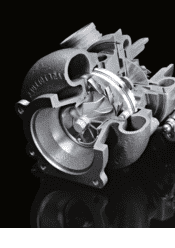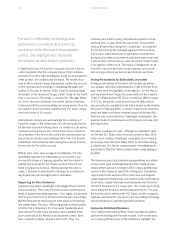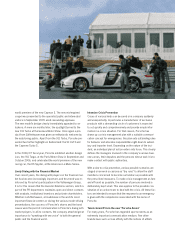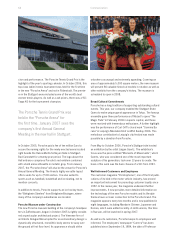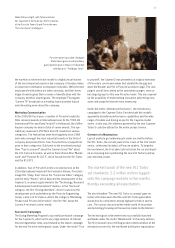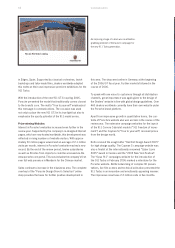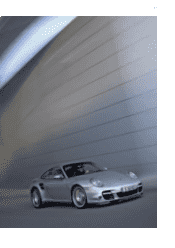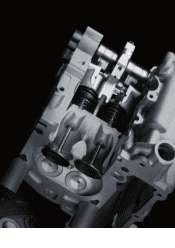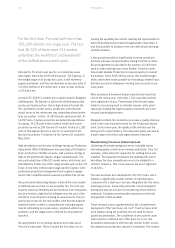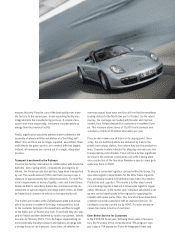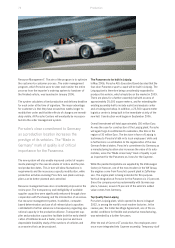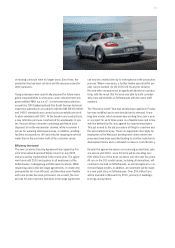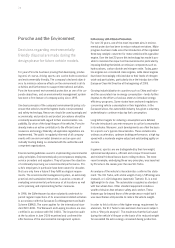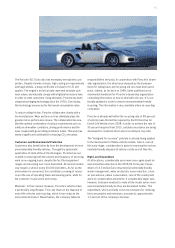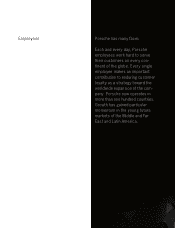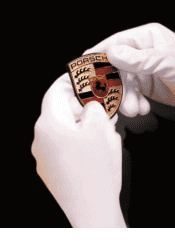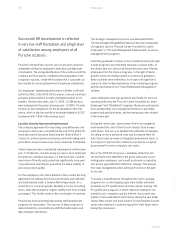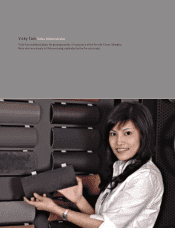Porsche 2005 Annual Report Download - page 72
Download and view the complete annual report
Please find page 72 of the 2005 Porsche annual report below. You can navigate through the pages in the report by either clicking on the pages listed below, or by using the keyword search tool below to find specific information within the annual report.70 Production
For the first time, Porsche built more than
100,000 vehicles in a single year. The fact
that 36,500 of these were 911 models
underlines the workforce’s achievements
at the Zuffenhausen parent plant.
Demand for Porsche’s new sports car models has never
been higher than in the 2005/06 fiscal year. The Cayenne, in
the twilight stage of its production cycle, is still extremely
popular worldwide, and Porsche therefore produced a total of
102,602 vehicles in the review year, a year-on-year increase
of 12.8 percent.
A total of 36,504 911 models were manufactured in Stuttgart-
Zuffenhausen. The Boxster is built at the Zuffenhausen plant
and by our Finnish partner. Due to high demand for both the
911 and Boxster model series, production of the Boxster
model series in the review year was undertaken almost entire-
ly by our partner. In total, 14,383 Boxster units were built. At
16,297 units, Cayman production exceeded all expectations.
In Leipzig, 35,128 units in the Cayenne model series were
produced as well as 290 Carrera GT models. A total of 1,282
units of this high-performance sports car were built in the
last two fiscal years. Production of the Carrera GT ceased in
May 2006.
High demand was not the only challenge facing our Production
department. While Zuffenhausen was operating at the highest
level, production of further versions, with volumes running as
high as the planned unit figures, began simultaneously. This
was particularly true of the 911 model series, which was com-
plemented by further top-of-the-range-models such as the 911
Turbo. A new entry in the product range was the Cayman. Com-
prehensive production management from supplier manage-
ment to the completed vehicle ensured a problem-free roll-out.
One particularly interesting feature is that all Porsche models
in Zuffenhausen are built on one assembly line. This not only
requires maximum flexibility and performance from employees
but also involves a high level of willingness on the part of the
workforce to participate in training at various levels. The pro-
duction processes for the new models were demonstrated to
industrial workers under a comprehensive training program.
Overall, demanding processes were completed without any
problems, and the targets were achieved for all production
launches.
All opportunities for increasing capacity were taken up at
Porsche’s main plant. These included the first steps for ex-
tending the assembly line and for realizing the opportunities to
optimize production processes throughout the value chain. It
was thus possible to produce more cars with almost unchang-
ed staff numbers.
It also proved possible to significantly increase overall pro-
ductivity, because all opportunities arising from the Location
Security Agreement concluded in the summer of 2005 were
used to make working hours more flexible. Porsche’s work-
time model enables Production to respond quickly to market
fluctuations. In the 2005/06 fiscal year, this involved longer
shifts, which were made possible by eliminating credited hours
that had accrued in employees’ working time accounts in pre-
vious years.
More pronounced teamwork played a particularly important
role. In the review year, more than 1,300 assembly workers
were organized in teams. These teams offer the best oppor-
tunity for structuring work in a flexible manner, while simul-
taneously meeting the highest quality standards and conti-
nuously improving processes.
Alongside problem-free production processes, quality improve-
ment is the most important maxim for the Production depart-
ment. In the review year, the quality of the vehicles was the
best yet in Porsche’s history. This improved quality was due to
a wide range of technical and organizational measures.
Manufacturing Processes further improved
Optimizing all manufacturing processes invariably means
improving quality as well as increasing productivity. Thus, for
example, a fully automatic apparatus for welding doors was
installed. The equipment measures the opening with a laser
and allows the door assembly process to be adapted to a
vehicle’s tolerance. This in turn ensures the exact alignment
of all joints.
The new aluminum door developed for the 911 Turbo, which
features a significantly smaller number of individual parts
compared with a steel door was also integrated into this manu-
facturing process. A new, fully automatic camera-equipped
testing unit ensures 100 percent monitoring of the vehicle’s
underside. Complete and exhaustive inspection of all seals
and gaskets is thus possible.
These measures were supplemented by the comprehensive
deployment of the “electronic job card”. Touch screens at all
work stations along the assembly line are used for direct
quality documentation. The completion of very specific work
tasks must be confirmed and, if this does not occur, the
assembled automobile is electronically locked, further assem-
bly stopped and production cannot be completed. This system



